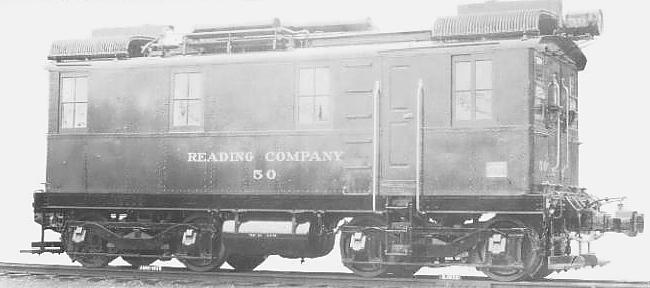Alco: AEGIR Boxcabs

The first diesel locomotive purchased by the Reading was the above 300 horsepower boxcab, which was constructed by the Alco / General Electric / Ingersoll-Rand consortium. Numbered #50 and assigned the Reading class OE-1 (Oil Electric, 1st type), the boxcab arrived in June, 1926. The Reading's boxcab was very similar to the Central of New Jersey's locomotive #1000 (the first successful diesel in the US), and was actually the second operational diesel locomotive in the nation. #50 spent most of her career in and around Reading Terminal in Philadelphia, where her small size allowed her to negotiate the tight curves of in-street trackage. In 1940, locomotive #50 was renumbered to #98, and was eventually scrapped in 1949, after nearly a quarter-century of service.
The second diesel locomotive to arrive on the property was Reading #51, another AGEIR boxcab delivered in 1928 and classified OE-2. The principal difference between these two locomotives was in their cooling system - #51's system had its cooling system on the roof in a boxlike structure behind the headlight. As with #50, Reading #51 was renumbered to #99 in 1940, but outlived the earlier boxcab by several years, as it was not retired until 1954, and scrapped in 1955.
MODELING NOTES: There are some commercially available boxcab kits, though one would need to work from prototype photos to kitbash a commercial kit to resemble either of the Reading's two boxcab locomotives. While their operation was very limited in scope to the Philadelphia area, having one of these models on your layout would be a testament to the Reading's forward thinking as it began the move towards diesel power over steam.
Did You Know?
Downloads
 A variety of Reading Company operations related documents, etc. that may be of use in your modeling efforts.
A variety of Reading Company operations related documents, etc. that may be of use in your modeling efforts.
 A variety of Reading Company operations paperwork, such as train orders, clearance forms, etc. that will help you operate your Reading layout in a prototypical manner.
A variety of Reading Company operations paperwork, such as train orders, clearance forms, etc. that will help you operate your Reading layout in a prototypical manner.
 Public Timetables, Employe Timetables, and Rulebooks that provide much useful operational information.
Public Timetables, Employe Timetables, and Rulebooks that provide much useful operational information.
 Signs, billboards, and other FREE goodies for your use. We ask only that you help spread the word about The Reading Modeler!
Signs, billboards, and other FREE goodies for your use. We ask only that you help spread the word about The Reading Modeler!

